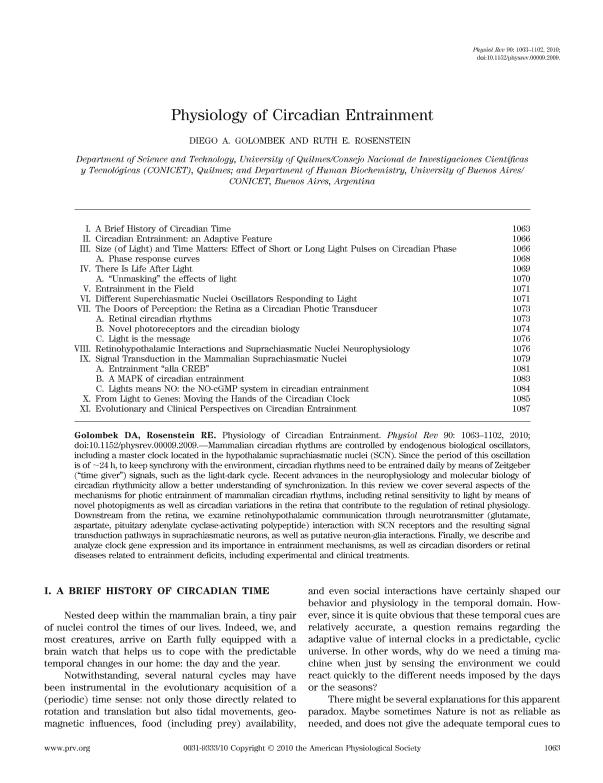Mostrar el registro sencillo del ítem
dc.contributor.author
Golombek, Diego Andres

dc.contributor.author
Rosenstein, Ruth Estela

dc.date.available
2017-06-06T19:38:14Z
dc.date.issued
2010-07
dc.identifier.citation
Golombek, Diego Andres; Rosenstein, Ruth Estela; Physiology of circadian entrainment; American Physiological Society; Physiological Reviews; 90; 3; 7-2010; 1063-1102
dc.identifier.issn
0031-9333
dc.identifier.uri
http://hdl.handle.net/11336/17613
dc.description.abstract
Mammalian circadian rhythms are controlled by endogenous biological oscillators, including a master clock located in the hypothalamic suprachiasmatic nuclei (SCN). Since the period of this oscillation is of ∼24 h, to keep synchrony with the environment, circadian rhythms need to be entrained daily by means of Zeitgeber (“time giver”) signals, such as the light-dark cycle. Recent advances in the neurophysiology and molecular biology of circadian rhythmicity allow a better understanding of synchronization. In this review we cover several aspects of the mechanisms for photic entrainment of mammalian circadian rhythms, including retinal sensitivity to light by means of novel photopigments as well as circadian variations in the retina that contribute to the regulation of retinal physiology. Downstream from the retina, we examine retinohypothalamic communication through neurotransmitter (glutamate, aspartate, pituitary adenylate cyclase-activating polypeptide) interaction with SCN receptors and the resulting signal transduction pathways in suprachiasmatic neurons, as well as putative neuron-glia interactions. Finally, we describe and analyze clock gene expression and its importance in entrainment mechanisms, as well as circadian disorders or retinal diseases related to entrainment deficits, including experimental and clinical treatments.
dc.format
application/pdf
dc.language.iso
eng
dc.publisher
American Physiological Society

dc.rights
info:eu-repo/semantics/openAccess
dc.rights.uri
https://creativecommons.org/licenses/by-nc-sa/2.5/ar/
dc.subject
Entrainment
dc.subject
Circadian
dc.subject.classification
Fisiología

dc.subject.classification
Medicina Básica

dc.subject.classification
CIENCIAS MÉDICAS Y DE LA SALUD

dc.title
Physiology of circadian entrainment
dc.type
info:eu-repo/semantics/article
dc.type
info:ar-repo/semantics/artículo
dc.type
info:eu-repo/semantics/publishedVersion
dc.date.updated
2017-06-01T16:45:50Z
dc.identifier.eissn
1522-1210
dc.journal.volume
90
dc.journal.number
3
dc.journal.pagination
1063-1102
dc.journal.pais
Estados Unidos

dc.description.fil
Fil: Golombek, Diego Andres. Universidad Nacional de Quilmes. Departamento de Ciencia y Tecnologia; Argentina. Consejo Nacional de Investigaciones Científicas y Técnicas; Argentina
dc.description.fil
Fil: Rosenstein, Ruth Estela. Universidad de Buenos Aires. Facultad de Medicina. Departamento de Bioquímica Humana; Argentina. Consejo Nacional de Investigaciones Científicas y Técnicas; Argentina
dc.journal.title
Physiological Reviews

dc.relation.alternativeid
info:eu-repo/semantics/altIdentifier/doi/http://dx.doi.org/10.1152/physrev.00009.2009
dc.relation.alternativeid
info:eu-repo/semantics/altIdentifier/url/http://physrev.physiology.org/content/90/3/1063.long
Archivos asociados
